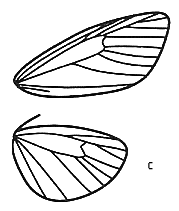|
Barsine
Walker Gen. rev.
Type species defecta Walker,
Nepal.
Synonyms:
Ammatho Walker (type species cuneonotatus Walker, Sri Lanka); Castabala
Walker (type species roseata Walker, India); Korawa Moore
(type species pallida Moore, India = perpallida Hampson); Mahavira
Moore (type species flavicollis Moore, India).
This genus is revived for
many of the robust species previously placed in Miltochrista Hübner. The
most consistent diagnostic feature is the presence of a field or fields of large
but short, asymmetric or otherwise irregular spines in the aedeagus vesica. A
spur from the centre of the valve costa, usually ventrally directed, is always
present. Distal costal and saccular processes are also frequently present, the
former particularly so. Apart from Ammatho, the type species of the
genus-group names in the synonymy have a distinctive and prominent spine from
more basally on the sacculus. On all Bornean species with this, the distal
saccular process is bifid, a feature of the type species of Barsine. Many
of the species are mainly red or have red markings on the forewings. The
venation is shown in Fig 4c. The female genitalia have only fine scobination in
the bursa, sometimes partly concentrated into a signum-like structure (Mahavira)

Fig. 4c: Barsine gratiosa Guerin
Typical Miltochrista (type
species rubicunda [Denis & Schiffermüller] = miniata Forster;
syn. Calligenia Duponchel, type species rosea Fabricius = miniata;
Europe) has large, well separated cornuti in the vesica, lacks a central
costal process on the valve and has extensive fields of long spines in the bursa
copulatrix.
In the Australian tropics
there flies a diverse assemblage of robust species with more rectangular
forewings having a more finely reticulate pattern. These species have a field of
more regular, smaller spines in the vesica, a strong central costal process on
the valve, but the distal costal process is absent. This group is probably more
closely related to Barsine than to Lyclene (e.g. in synonymy in
Nielsen et al.(1996)). The oldest available generic name is Cyme Felder
(type species reticulata Felder, Ambon) Gen. rev., with Prinasura
Hampson (type species pyrrhopsamma Hampson = structa Walker;
syn. Pallene Walker praeocc., type species structa Walker;
Australia) as a probable synonym.
Somewhat similar to Cyme is
Nepita Moore (= Pitane Walker praeocc., type species conferta
Walker, Sri Lanka) Gen. rev., a monobasic genus with a vesica as in Cyme
but rather ovate valves ornamented only with a robust central costal
process. The female genitalia have the bursa immaculate apart from a small,
lens-shaped patch of scobination. The larva has secondary setae on verrucae and
feeds on moss and lichen (T.R.D. Bell, MS). The cylindrical eggs are laid in
batches or sheets, covered with abdominal hair, usually on stones or tree bark.
The Bornean species included
in the section following show progressive divergence from the strict definition
of Barsine, and some probably should be assigned to other, possibly new
genera. Comments on this will be made in the taxonomic notes for each. The first
four species are typical of Barsine.
<<Back
>>Forward <<Return
to Contents page
|

